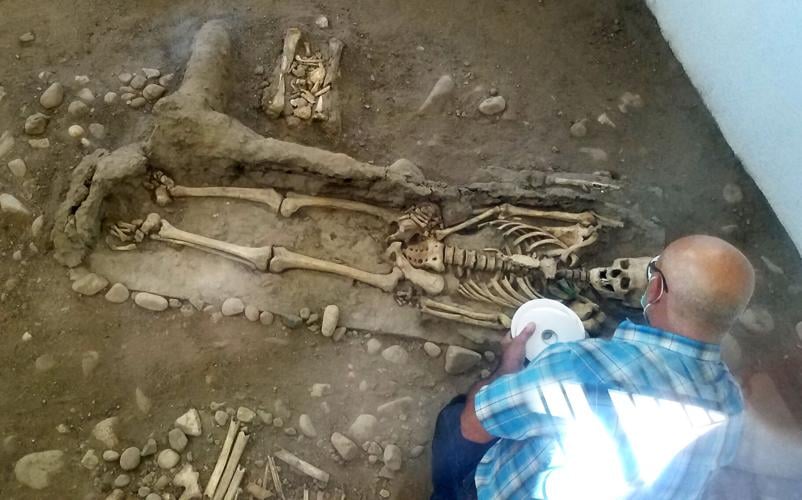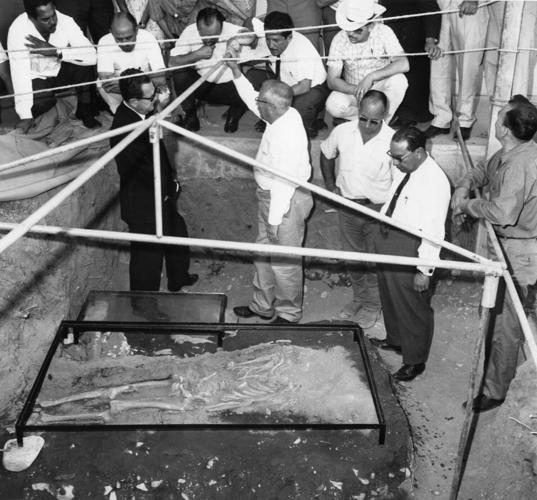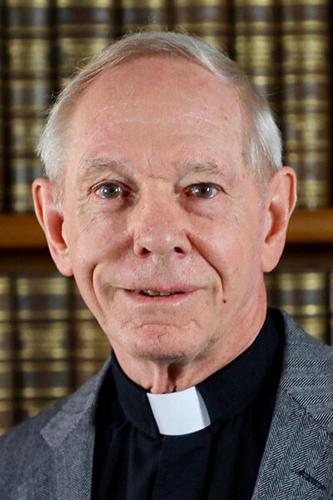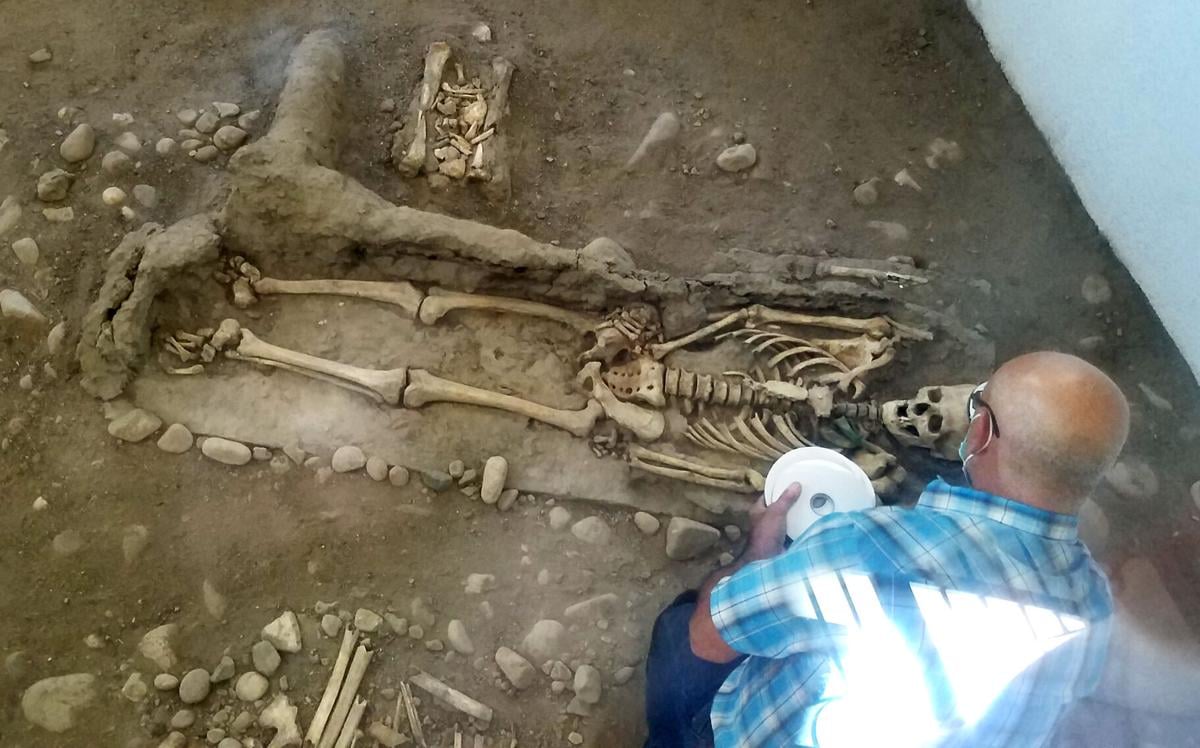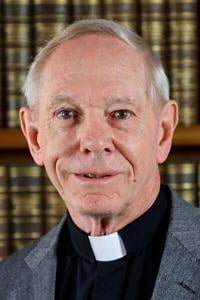The mausoleum crypt holding Padre Eusebio Francisco Kino’s remains in Magdalena de Kino, Sonora, was opened Wednesday so that a Tucson organization promoting Kino’s canonization could obtain a relic.
The opening of the crypt by the Mexico’s National Institute of Anthropology was requested by Bishop Edward J. Weisenburger of the Roman Catholic Diocese of Tucson on behalf of the Kino Heritage Society. The society educates the public and promotes the cause for Kino’s sainthood. The organization is affiliated with the diocese.
José Luis Perea González, an anthropologist who is the director of Mexico’s National Institute of Anthropology and History Center in Hermosillo, the capital of Sonora, authorized the opening and closing of the crypt.
The procedure was done in private by the institute’s conservator, Rodolfo Castillo Lopez, an anthropologist who wore latex gloves, a face mask, knee pads and used a brush to restore the area he touched in the tomb. Kino’s visible skeletal remains, which are under plexiglass, are in the mausoleum crypt at La Plaza Monumental, about 50 yards from María Magdalena Church.
Anthropologist Rodolfo Castillo Lopez, of Mexico’s National Institute of Anthropology and History, is placing five spools of black ribbon on the skull of Padre Eusebio Francisco Kino inside the crypt in Magdalena de Kino, Sonora.
The ribbon is now a third-relic of would-be saint Padre Kino and will be put on prayer cards to promote his canonization by Tucson’s Kino Heritage Society. The unsealing of the crypt was requested by Bishop Edward J. Weisenburger of the Roman Catholic Diocese of Tucson on behalf of the Kino Heritage Society. Video courtesy of Lupita Teran.
The crypt was opened for the Kino Heritage Society to obtain what is called a third-class relic from Kino who is a candidate for sainthood. A third-class relic is an object that has touched a body part of a saint or would-be saint, or a possession that a saint or would-be saint owned, according to Vatican rules.
In this case, the third-class relic was reels of black ribbon, representing the Jesuit cassock, that were placed in the crypt by Lopez, touching the skull of Kino, said the Rev. Gregory Adolf, who was among the delegation from the Tucson diocese to attend the event in Magdalena de Kino, about a 2½-hour drive south from Tucson.
The Rev. Gregory Adolf witnessed the unsealing of the crypt with the remains of Father Eusebio Kino.
Before the event, Lopez checked the interior of the crypt and found it to be “in good shape with no signs of deterioration,” said Adolf. Lopez handed the reels of ribbon to Adolf after the reels touched Kino’s skull. Lopez then closed and locked the crypt where access to Kino’s remains has been rare during the last 50 years, and is only authorized by the institute, Adolf said.

The Rev. Gregory Adolf hands reels of ribbon to Rodolfo Castillo Lopez who is inside the tomb of Padre Eusebio Francisco Kino in Magdalena de Kino, Sonora. Adolf is among the delegation of the Roman Catholic Diocese of Tucson, and took the ribbon to Magdalena so that it can become a third-class relic of the would-be saint Kino.
Adolf is a board member of the Kino Heritage Society and member of the board of directors of the Southwest Mission Research Center, which promotes borderland history and also sponsors tours in Arizona and Sonora of Kino missions.
“This was deeply moving because I have seen the remains many, many times through the plexiglass, but to have the tomb open and looking in on the ground level straight at Father Kino’s bones was very touching,” said Adolf. “I was very impressed by the wonderful cooperation by the local authorities and the National Institute of Anthropology and History to make this possible,” he said, explaining that pilgrims arriving at the tomb were held back by a gate while the process to obtain the third-relic was taking place. The crowd stood in silence.
“It was a beautiful sunny day and about 40 people waited to catch an unexpected glimpse into history,” said Adolf.
The ribbon will be cut into tiny pieces that will go on 20,000 prayer cards that will be distributed to diocesan parishes to promote Kino’s cause for sainthood. The prayer cards are being donated to the society by Frank Barco, owner of the Copper Queen Publishing Co., Inc. in Bisbee, said Rosie Garcia, president and founder of the Kino Heritage Society. One reel of ribbon will be given to Kino’s descendants in Segno, Italy.
“Gathering a third-class relic from Kino’s crypt is most appropriate now that the good padre has been declared ‘venerable,’” said Rev. Christopher Corbally, a Jesuit Vatican astronomer and heritage society board member, in regards to Kino’s candidacy for sainthood. “Relics of saints help us recall that these holy people were as real as ourselves, they walked our walk, and so can be an inspiration to our own journey,” said Corbally.
The Rev. Christopher Corbally, a Jesuit Vatican astronomer.
“Relics, such as this one of Kino, help us to remember to call on those in heaven for help. They are our friends and family, and they care for us,” Corbally said. “Yes, we can always go straight to God with our needs but, as in our present life, it feels good to have the support of friends when we have a special request to make of someone with authority. Praying for something really special to God like this, with the support of such as Padre Kino on the way to be declared “saint,” has the two effects: it opens us to God’s answer; and it confirms that the padre is indeed close to God in heaven,” said Corbally.

Conservator and anthropologist Rodolfo Castillo Lopez, of Mexico’s National Institute of Anthropology and History, touches the reels of ribbon to Padre Eusebio Francisco Kino’s skull in the tomb.
In July 2020, Pope Francis approved that Kino be declared a “venerable” person, which is two steps away from sainthood. At that time, Bishop Weisenburger said the pope’s formal approval recognized Kino’s life of “heroic virtue.”
“Padre Kino is especially recognized as an extraordinary example of evangelization, science and respect for the dignity of the poor,” wrote Weisenburger in an email to parishioners of the diocese.
The process to canonize Kino began in the 1960s and it started in Hermosillo.
According to the U.S. Conference of Catholic Bishops website, after a candidate becomes venerable, the next step is blessed and then canonized as a saint.
“To be beatified and recognized as a blessed, one miracle acquired through the candidate’s intercession is required in addition to recognition of heroic virtue or martyrdom. Canonization requires a second miracle after beatification, though a pope may waive these requirements,” according to the site.
The society would not disclose what it paid the institute for the costs to obtain the relic. The money came from a trust fund established by the late Jesuit Rev. Charles W. Polzer, a Kino historian and anthropologist, to support events promoting and celebrating the canonization process of Kino.
Kino, who left a legacy as a Jesuit missionary, explorer, cartographer, rancher and farmer, was born Eusebio Chini on Aug. 10, 1645, in Segno, Italy, and died March 15, 1711, at age 65 in Magdalena. He founded 21 missions in the Pimería Alta — what is now Northern Sonora and Southern Arizona.
Among the missions are Tumacácori mission that was established by Kino in 1691 but later built under Franciscan missionaries. In 1700, Kino laid the foundation for a mission at the village of Bac, on the Santa Cruz River near Tucson. Mission San Xavier del Bac — also known as the White Dove of the Desert — was completed in 1797 also by Franciscan missionaries.

The remains of Father Kino are under glass after they were discovered in Magdalena, Sonora, in May 1966. On hand for a ceremony celebrating the discovery are, from left, Son Gov. Luis Encinas; Dr. Jimenez Moreno, who led the expedition; Dr. William Masley, archaeologist from the Arizona State Museum; and Magdalena Mayor Nava Garcia.
According to writings by Polzer, Padre Kino’s bones were found May 19, 1966, by a binational team of experts, including archaeologists and historians involved in methodical excavations. The work was commissioned by the Mexican federal government.
The remains were discovered where they had been buried some 255 years earlier. They were found under the Chapel of St. Francis Xavier that Kino had built in what is now the Plaza de Magdalena. In the remains, was a cassock button and a small crucifix, according to writings by the late Bernard L. “Bunny” Fontana, also an anthropologist and historian.
“That Kino’s remains were discovered in 1966 has to be regarded as miraculous. The same might be said for the continuation of so much that he set in motion in Northern Sonora/Southern Arizona more than three centuries ago,” wrote Fontana about the discovery and Kino’s accomplishments.
Photos: Father Kino (Eusebio Francisco Kino)
Eusebio Francisco Kino, Father Kino
Updated
A woman prays at the temporary crypt of Father Kino in Magdalena, Son., in July, 1966.
Eusebio Francisco Kino, Father Kino
Updated
Eusebio Francisco Kino in a painting by Tucson artist Frances O'Brian.
Eusebio Francisco Kino, Father Kino
Updated
The remains of Father Kino under glass after discovery in the south end of the front lawn used to be at Magdalena, Son., City Hall in May, 1966. On hand for a ceremony celebrating the discovery are, from left, Son Gov. Luis Encinas, Dr. Jimenez Moreno, who led the expedition, Dr. William Masley, archaeologist from the Arizona State Museum and Magdalena Mayor Nava Garcia.
Eusebio Francisco Kino, Father Kino
Updated
Crowds gather around the remains of Father Kino at Magdalena, Son., City Hall in May, 1966.
Eusebio Francisco Kino, Father Kino
Updated
An archaeological expert from the University of Mexico examines the skull of Father Kino in July, 1966.
Eusebio Francisco Kino, Father Kino
Updated
Vendors' tents fill the plaza outside of Santa Maria Magdalena during the annual religious pilgrimage and festival to honor St. Francis Xavier in Magdalena, Sonora, Mexico, in 2006.
Eusebio Francisco Kino, Father Kino
Updated
Father Rodolfo Garza blesses the horses and riders of Por Los Caminos de Kino as they embark on the 26th Kino Cabalgata in 2013, at the Tumacácori National Historical Park. 30 riders from Arizona and Sonora, commemorate Father Kino's 75-mile, 24-hour ride on horseback from Tumacácori to San Ignacio to save an innocent man's life. The ride ends at Father Kino's tomb in Magdalena.
Eusebio Francisco Kino, Father Kino
Updated
The members of Por Los Caminos de Kino embark on horseback for the 26th Kino Cabalgata in 2013 to commemorate Father Kino's 75-mile, 24-hour ride on horseback from Tumacácori to San Ignacio to save an innocent man's life.
Eusebio Francisco Kino, Father Kino
Updated
San Xavier del Bac Mission. Historic American Buildings Survey, Donald W. Dickensheets, Photographer. April 10, 1940 GENERAL VIEW MAIN CHURCH (SOUTHWEST ELEVATION). Photos from Survey HABS AZ-13
Eusebio Francisco Kino, Father Kino
Updated
San Jose de Tumacacori (Mission, Ruins). Historic American Buildings Survey Frederick D. Nichols, Photographer 1937 GENERAL VIEW FROM SOUTHWEST
Eusebio Francisco Kino, Father Kino
Updated
Statue of Father Kino at Kino Parkway and 15th St.


